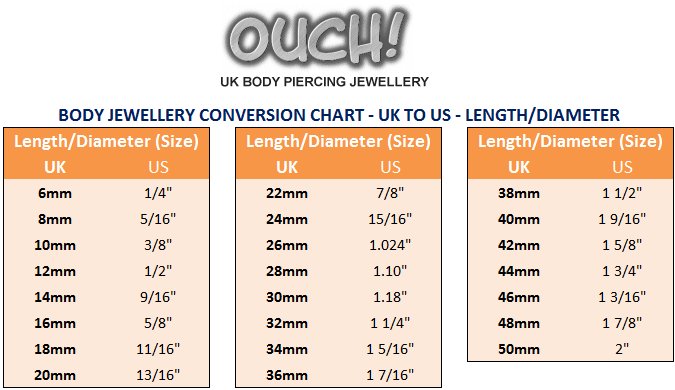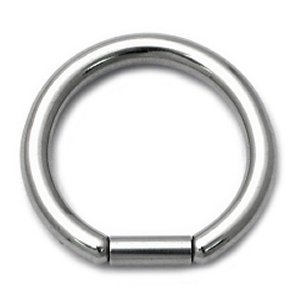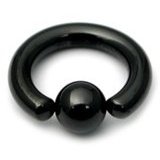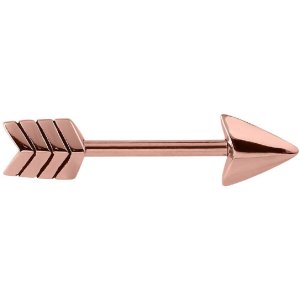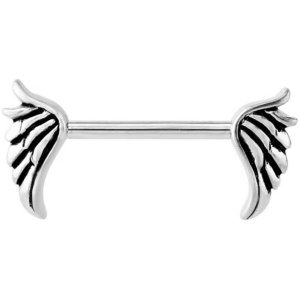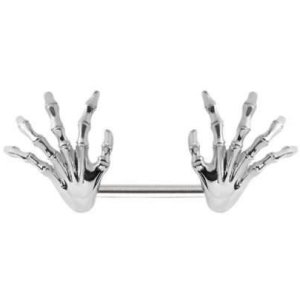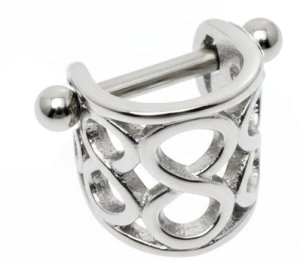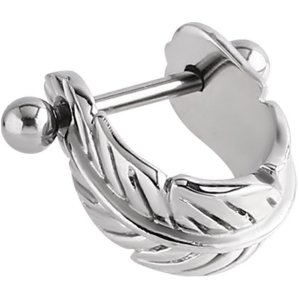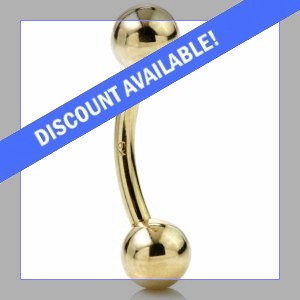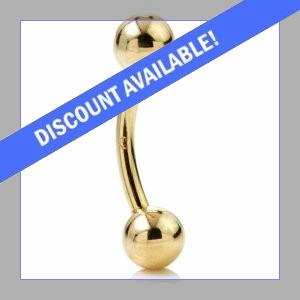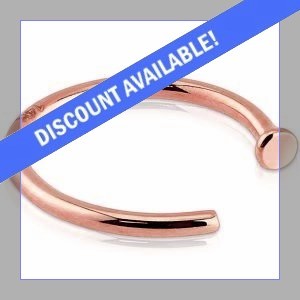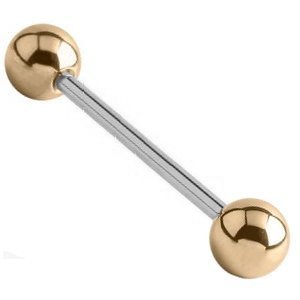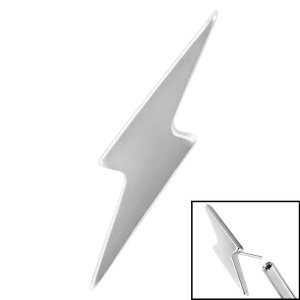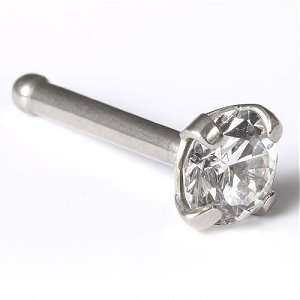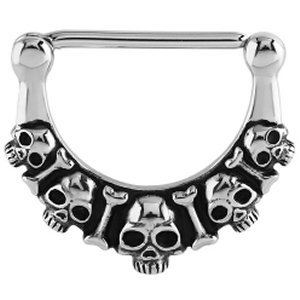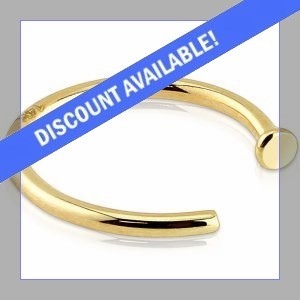Choosing the Correct Size of Body Jewellery
One of the first things to consider when buying body piercing jewellery is how to choose the correct size. So in this article we are going to discuss the following: how exactly is piercing jewellery measured? There are two main points to take into consideration when measuring body piercing jewellery: the first is the gauge and the second is the size. Both of these measurements are described in detail below, and you'll also find lots of helpful information on our Sizing Guide.
Body Jewellery - What Is The Gauge?
The gauge, quite simply, is the thickness of the bar which is inserted through your piercing ("he's wearing a 1.2mm eyebrow bar"). In the same way, the gauge also refers to the thickness of your piercing ("she has a 1.6mm lip piercing"). Here in the UK the gauge is measured in millimetres. In the US, the gauge is specified using the suffix 'ga' after one or two digits. It's important to note that the gauge has nothing at all to do with the length of the bar, or the diameter of a ring - that is covered further down this article. See our full conversion chart below:-
How Do I Choose The Correct Gauge?
There are standard gauges associated with the most common types of piercing. For example, navel piercings are created using a 1.6mm gauge needle (this means that the needle is 1.6mm thick). So, all the belly bars that you see for sale (whether on the internet or on the high street) have a gauge of 1.6mm - that's the thickness of the curved section which sits inside your piercing. Likewise for tongue bars, nipple bars, nipple rings and nipple shields - they are all 1.6mm gauge (regardless of the shape). Cartilage (ear) piercings are commonly created with a gauge of 1.2mm gauge, although some are created with a gauge of 1mm. It depends on your piercer, the location of your piercing and often your own personal preference. Lip piercings can be either 1.2mm or 1.6mm gauge, the same with eyebrow piercings. Nose piercings are commonly created with a 1mm needle, although again this can vary (0.8mm and 1.2mm can also be used for nose piercings).
Ear lobe tunnels and plugs are also measured by the gauge. A 10mm plug will fit into an ear lobe piercing which has been stretched to a diameter of 10mm. The same 10mm plug will fall out of a 16mm ear lobe piercing, and you won't be able to insert it into an 8mm ear lobe piercing because the plug will be too large.
Ear stretchers (tapers, expanders) also use the word 'gauge' to refer the thickness of the jewellery - specifically at the widest end of the stretcher. When you see a 6mm stretcher for sale, the thickest end will measure 6mm in diameter (the thinnest end, in comparison, might have a diameter of 1mm or 2mm). If your ear lobe piercing is currently 5mm and you want to stretch it to 6mm, you would need to buy a 6mm stretcher. You would begin by inserting the thinnest end into your piercing and then pushing it through slowly. When the 6mm end is sitting comfortably in your piercing, you will have successfully achieved a 6mm piercing - the diameter of your piercing hole will be 6mm. Don't go pushing the stretcher through quickly though - very important! We have a ton of advice and tips in our Ear Stretching Guide - it's an absolute must-read for every new stretching enthusiast.
What Would Happen If I Bought The Wrong Gauge?
Quite simply, if you bought a bar which was too thick you would struggle to get it into your piercing. On the other hand, if you wore a bar which was too thin, the gauge of your piercing might reduce (or 'shrink') over time. Here's an example - if you lost your belly bar and the only piece of body jewellery you could find in your box was an eyebrow bar with a gauge of 1.2mm, you may be tempted to use that to avoid your navel piercing closing up, and that would be absolutely fine. However, if you kept the eyebrow bar in your navel piercing for an extended amount of time (and that varies from person to person, there is no rule governing how quickly piercings start to heal or reduce) you then risk the gauge of your piercing permanently shrinking to 1.2mm gauge. The big disadvantage of this would be that your piercing would no longer be the correct gauge for regular belly bars and you would either have to 'stretch' the gauge of your piercing back to 1.6mm (it can be done) or you would have to continue wearing a 1.2mm bar. However, in doing the latter you would have pretty much zero chance of finding nice belly bars, because belly bars with a gauge of 1.2mm are virtually non-existent. It would be so much better to ensure that your navel piercing remains at 1.6mm gauge, so that you can continue to enjoy the vast selection of beautiful belly bars which are available today.
Body Jewellery - What Is The Size?
The 'size' has nothing to do with the gauge mentioned above. Nor does it have anything to do with the measurement of any decoration on the jewellery - for example, the size of a height/width of a heart on a jewelled heart belly bar. The size relates to the length of a barbell, a labret or a curved barbell (banana) or the internal diameter of any kind of piercing ring. The "size" also refers to the length of your piercing - commonly this means the distance between the two piercing holes.
Buying The Correct Size
Your task, when buying new body piercing jewellery, is to select the correct size of bar to correctly fit the size of your piercing. The good news is that it's usually not that difficult to do and it's even easier if you already have a piece of jewellery in your piercing which you can take out and measure.
Take a look at the illustrations below to see how barbells, bananas (also known as curved barbells), labrets, rings, plugs/tunnels and balls are measured:-
How To Measure The Various Shapes Of Body Jewellery
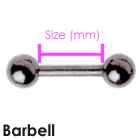
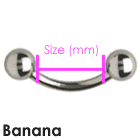
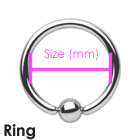
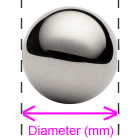
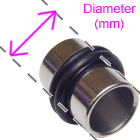
These illustrations are taken from our Sizing Guide.
What Happens If I Select The Wrong Size?
If you select a bar which is too short (or a ring which is too narrow) then your piercing will be "pinched". This is not good for your piercing for three reasons: restriction of airflow to the piercing, the risk of infection and the possibility of causing permanent damage to the skin around your piercing. On the contrary, if you select a bar which is too long (or a ring which is too wide) you risk the jewellery being caught on your clothing, which in turn increases the risk of wounding or even tearing to your piercing.
How Should The Correct Size Look?
The correct look is achieved when the skin is showing no signs of being pinched whilst the piercing is relaxed (ie, when you are not holding the piercing or the jewellery in any way). In addition, and using a barbell as an example, the two balls should sit comfortably next to the two piercing holes with hardly any of the bar section being on display. However, your own personal preference plays a part in it too: if you want to have some of the bar showing, then go ahead! There are no hard and fast rules and that is the wonderful beauty of body jewellery: be as diverse as you like, but just remember to be sensible and safe at the same time.
A Handy Little Tip
Next time you get a new piercing, ask your piercer to write down the gauge and size of the piece of jewellery which is being inserted into your piercing. If you are having a barbell or a labret fitted, ask for the gauge and the length. If you are having a ring fitted, ask for the gauge and the internal diameter. You can then refer to this information when you are buying new body jewellery and it will help you greatly when you are working out which size to buy.
Questions?
We are here to answer all of your questions about how body jewellery is measured and of course any other questions you may have. You can call us on (01253) 310265 Monday to Friday 9am to 5pm, or you can Contact Us through our website. Our website's Livechat feature is normally open seven days a week until late and our friendly chat staff will be pleased to answer your questions or give you guidance on selecting the perfect piece of body jewellery.

